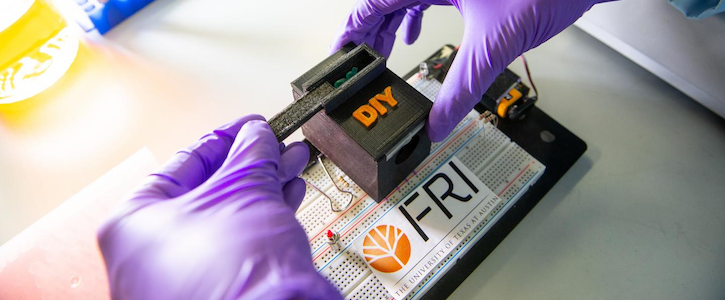New Tech Uses Smartphone Camera to Determine Whether Mosquitoes Carry Disease, Biopesticide
The diagnostic tool could improve public health efforts at a critical time.

Photo has been cropped and resized. Courtesy of Vivian Abagiu/University of Texas at Austin
For public health officials, the fight against mosquito-borne diseases is ever-evolving and ever-important. In recent years, scientists have turned to a biopesticide called Wolbachia to help stop mosquitoes from spreading diseases like Zika, dengue, chikungunya and yellow fever. But now, public health has a way to tell almost instantly whether such campaigns are yielding results.
Researchers at the University of Texas at Austin have developed a diagnostic tool that can “quickly and cheaply” determine whether a given mosquito belongs to the Aedes aegypti species, which carries these infectious diseases. What’s more, the system can tell whether the insect has had any contact with Wolbachia, according to a study detailing the tech.
>> READ: Considering Medical Cannabis? There’s a DNA Test for That
The public health implications of such a technological breakthrough could be significant. Over the past 14 years, this species has played a role in tripling the number of mosquito-fueled disease cases in the U.S., according to researchers.
“Many of these diseases are spreading in areas where they weren’t common before,” Sanchita Bhadra, the paper’s first author and a research associate in the school’s molecular biosciences department, said in a statement. “Having surveillance is important in conjunction with any kind of outbreak, and this method allows a rapid test in the field.”
Her tool comprises a smartphone camera, a 3D-printed box and a chemical test. Together, these components adeptly identify the presence of the biopesticide, which is difficult and expensive to detect under current diagnostic testing standards. It provides a “yes” or “no” response on a user’s cellphone, clocking in at 97 percent accuracy.
The new system enables public health officials to test mosquitoes when they are not in a state of decay, which is standard now.
“Our easy-to-use and easy-to-interpret assays should facilitate widespread field mosquito surveillance with minimal instrumentation and high accuracy,” the authors wrote.
Get the best insights in healthcare analytics directly to your inbox.
Related
What Prime Day Genetic Testing Deals Say About Healthcare’s Future
Smart Inhalers Lead to Decreased Usage, Fewer Symptoms in Asthma, COPD Patients
Paired with a Good Algorithm, a Smartphone Camera Might Detect Heart Disease